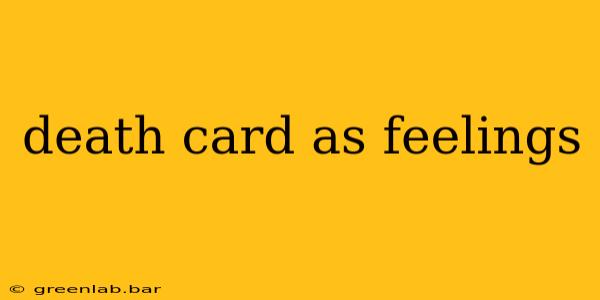The Death card in tarot is often misunderstood. Instead of literal death, it signifies profound endings, necessary transformations, and the emotional upheaval that accompanies such significant life changes. Understanding the Death card's emotional landscape is key to interpreting its message accurately, and this exploration dives deep into the spectrum of feelings associated with this powerful card.
The Spectrum of Emotions: From Fear to Freedom
The Death card's emotional impact isn't singular; it's a complex tapestry woven from a variety of intense feelings. Let's unpack some of the most prominent ones:
1. Fear and Anxiety: The Shadow of the Unknown
Facing the unknown is inherently daunting. The Death card often signals the end of a familiar chapter, triggering fear and anxiety about what lies ahead. This isn't necessarily fear of physical death, but rather fear of loss – loss of identity, relationships, security, or the familiar comfort of the status quo. This anxiety manifests as uncertainty, apprehension, and a sense of being overwhelmed by the magnitude of change.
2. Grief and Sadness: Letting Go of the Past
Transformation requires letting go. The Death card often signifies the need to mourn past experiences, relationships, or belief systems that no longer serve your highest good. This process involves acknowledging the grief and sadness that arise from relinquishing what was once cherished. This isn't about dwelling on the past; it's about accepting the necessary endings to make way for new beginnings.
3. Anger and Frustration: Resistance to Change
Change can be frustrating, especially when it feels imposed or uncontrollable. The Death card's message might trigger anger and frustration, stemming from resistance to the necessary transformation. This anger isn't necessarily negative; it can be a powerful catalyst for action, propelling you to confront obstacles and actively participate in the process of change.
4. Relief and Liberation: The Dawn of New Possibilities
While the initial emotional response might be fear or sadness, the Death card ultimately points toward liberation. As you release the old, you create space for new possibilities. This can bring a profound sense of relief and liberation, a feeling of shedding heavy burdens and stepping into a brighter future. This is the potential for growth and renewal that lies at the heart of the Death card's transformative energy.
5. Excitement and Hope: Embracing the Future
The transformative journey signified by the Death card culminates in a sense of excitement and hope. This is the anticipation of new experiences, fresh perspectives, and the potential for personal growth. This hope isn't naive; it's rooted in the understanding that endings are necessary for new beginnings, and that this process, while challenging, ultimately leads to greater self-awareness and fulfillment.
Navigating the Emotional Landscape
The Death card's emotional impact is profound and multifaceted. Rather than fearing its message, embrace it as an opportunity for deep personal growth. Acknowledge the full spectrum of emotions that arise – the fear, the grief, the anger, and ultimately, the relief, excitement, and hope. By actively processing these feelings, you can navigate the transformative journey with greater clarity and emerge stronger and more resilient on the other side. Remember, the Death card isn't about an end; it's about a powerful transformation leading to rebirth and renewal.

